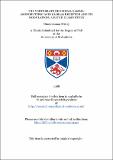The vertebrate neuronal gamma-aminobutyric acid (GABAa) receptor and its modulation: a patch clamp study
Abstract
Pressure application of gamma-aminobutyric acid (GABA) to mouse spinal and rat DBG neurones maintained in culture evoked transient membrane currents. Using the whole-cell patch clamp technique, these currents were shown to primarily involve the flow of Cl-. The GABA-evoked whole-cell currents in both types of neurones were reversibly suppressed by the GABAA antagonist bicuculline. The barbiturate phenobarbitone reversibly potentiated GABA-evoked whole-cell currents in mouse spinal neurones. Attempts to look at the unitary currents activated by GABA in outside-out patches, revealed spontaneous unitary currents. The I-V relationships of the spontaneous currents were linear and had a reversal potential of OmV in symmetrically distributed Cl solutions. Changing the monovalent cation concentrations on one or both sides of the membrane patch had no effect on the amplitude or the reversal potential of the spontaneous currents. Replacing some of the Cl- in the patch pipette with the impermeant anion SO42- shifted the reversal potential to more negative values. These spontaneous currents in both types of neurones were blocked by bath perfusion of bicuculline. GABA-activated unitary currents in outside-out patches, the main conductance state in both types of neurones was 30pS. However, GABA could occasionally also activate other conductance levels. Spontaneous Cl- currents did not occur in cell-attached patches from mouse spinal and rat DRG neurones, suggesting that the spontaneous events in the outside-out patches did not represent the activity of voltage dependent Cl- channels. Alphaxalone, a steroid anaesthetic, potentiated GABA-evoked whole cell currents in both spinal and DRG neurones. At high (muM) concentrations, pressure application of alphaxalone evoked a membrane Cl- current; this current was reversibly suppressed by blcuculline and potentiated by phenobarbitone. Pregnanolone (5beta-pregnane-3x-ol-20-one) a progesterone metabolite at low (nM) concentrations reversibly enhanced GABA currents in spinal neurones. Pregnanolone at higher concentrations pressure applied to spinal neurones had a weak direct agonist action on the GABAA receptor. Pregnanolone prolonged the burst duration of GABA-activated unitary currents in outside-out patches from spinal neurones. Some of the actions of the steroids on the GABAA receptor were very similar to the barbiturates, bemegride, a respiratory stimulant was formerly used clinically to counteract barbiturate poisoning in man. Experiments were conducted to see whether bemegride could be used as a specific barbiturate antagonist. Bemegride reduced phenobarbitone enhanced GABA currents in mouse spinal neurones. However, bemegride alone also reduced GABA and pentobarbitone evoked currants to a similar extent. This is suggestive of a noncompetitive action on the GABAA receptor, therefore it was not used to elucidate the site of action of steroids.
Type
Thesis, PhD Doctor of Philosophy
Collections
Items in the St Andrews Research Repository are protected by copyright, with all rights reserved, unless otherwise indicated.

